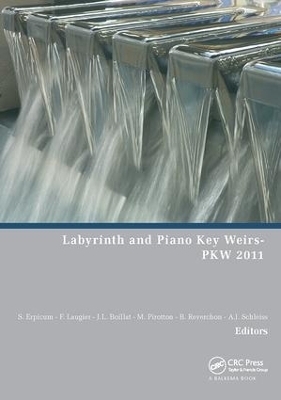
Labyrinth and Piano Key Weirs
Seiten
2017
CRC Press (Verlag)
978-1-138-11538-5 (ISBN)
CRC Press (Verlag)
978-1-138-11538-5 (ISBN)
Labyrinth spillways are almost as old as dam engineering. In spite of the fact that they appear as a very good technical-economical compromise, only 0.1% of large dams are equipped with such weirs. The main reason for this is that traditional labyrinth weirs usually cannot be installed on top of concrete gravity dams as they require a large foundation surface. In 2003 an improved concept of traditional labyrinth spillway emerged, with alveoli developed in overhangs from a reduced support area: the Piano Key Weir (PKW). The Piano Key Weir is a weir of particular geometry, associating to a labyrinth shape the use of overhangs to reduce the basis length. The main advantage of Piano Key Weirs is that it can be directly placed on a dam crest. As a result of extreme fl oods in the recent past, a growing demand for safety in society, and revised hydrological calculations, the need for reliable spillways has consequently become higher. In this context, the Piano Key Weir proves to be an interesting solution to increase the hydraulic capacity of spillway devices.
The book contains the state-of-the-art on this still non-conventional hydraulic structure, and is divided into six main themes:
Physical Modeling. Hydraulic capacity
Physical Modeling. Downstream fittings
Numerical Modeling
Hydraulic Design
Planned and achieved projects
Nomenclature, Database, Future developments.
The papers in Labyrinth and Piano Key Weirs demonstrate that dam engineering currently experiences a strong revival of labyrinth oriented weirs, and are particularly of interest to academia, researchers and professionals working in the area of hydraulic engineering, and to dam control authorities and dam owners.
The book contains the state-of-the-art on this still non-conventional hydraulic structure, and is divided into six main themes:
Physical Modeling. Hydraulic capacity
Physical Modeling. Downstream fittings
Numerical Modeling
Hydraulic Design
Planned and achieved projects
Nomenclature, Database, Future developments.
The papers in Labyrinth and Piano Key Weirs demonstrate that dam engineering currently experiences a strong revival of labyrinth oriented weirs, and are particularly of interest to academia, researchers and professionals working in the area of hydraulic engineering, and to dam control authorities and dam owners.
Sébastien Erpicum, Frédéric Laugier, Jean-Louis Boillat, Michel Pirotton, Bernard Reverchon, Anton L. Schleiss
Keynote lectures Physical modeling – Hydraulic capacity Numerical modeling Hydraulic design Planned and existing projects Nomenclature, data base, future developments
| Erscheinungsdatum | 04.07.2017 |
|---|---|
| Verlagsort | London |
| Sprache | englisch |
| Maße | 174 x 246 mm |
| Gewicht | 453 g |
| Themenwelt | Technik ► Bauwesen |
| Technik ► Umwelttechnik / Biotechnologie | |
| ISBN-10 | 1-138-11538-X / 113811538X |
| ISBN-13 | 978-1-138-11538-5 / 9781138115385 |
| Zustand | Neuware |
| Informationen gemäß Produktsicherheitsverordnung (GPSR) | |
| Haben Sie eine Frage zum Produkt? |
Mehr entdecken
aus dem Bereich
aus dem Bereich
Grundlagen und Vorgehensweisen
Buch | Softcover (2021)
Springer Fachmedien Wiesbaden GmbH (Verlag)
37,99 €
ein Leitfaden zu bahnbezogenen Infrastrukturthemen
Buch | Softcover (2024)
Springer Vieweg (Verlag)
44,99 €
Bemessung von Stahlbauten nach Eurocode mit zahlreichen Beispielen
Buch | Hardcover (2024)
Springer Vieweg (Verlag)
59,99 €


